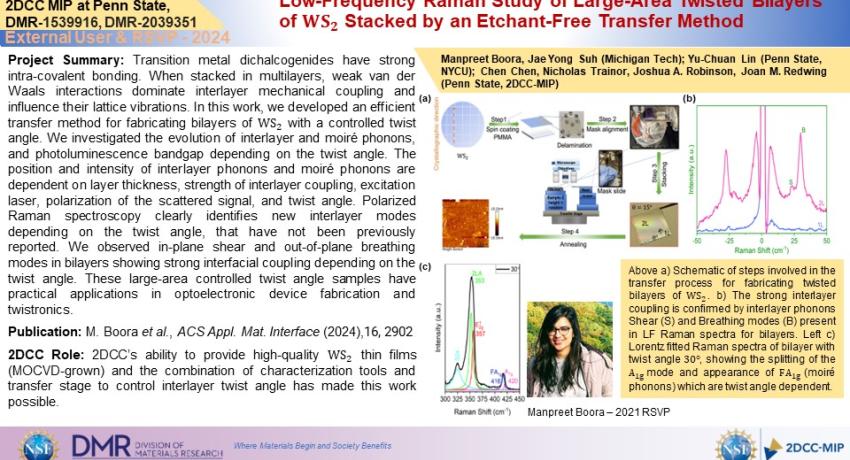Transition metal dichalcogenides have strong intra-covalent bonding. When stacked in multilayers, weak van der Waals interactions dominate interlayer mechanical coupling and influence their lattice vibrations. In this work, we developed an efficient transfer method for fabricating bilayers of WS2 with a controlled twist angle. We investigated the evolution of interlayer and moiré phonons, and photoluminescence bandgap depending on the twist angle. The position and intensity of interlayer phonons and moiré phonons are dependent on layer thickness, strength of interlayer coupling, excitation laser, polarization of the scattered signal, and twist angle. Polarized Raman spectroscopy clearly identifies new interlayer modes depending on the twist angle, that have not been previously reported. We observed in-plane shear and out-of-plane breathing modes in bilayers showing strong interfacial coupling depending on the twist angle. These large-area controlled twist angle samples have practical applications in optoelectronic device fabrication and twistronics.
Publication: M. Boora et al., ACS Appl. Mat. Interface (2024),16, 2902
2DCC Role: 2DCC’s ability to provide high-quality WS2 thin films (MOCVD-grown) and the combination of characterization tools and transfer stage to control interlayer twist angle has made this work possible.
What Has Been Achieved: First highlight of our work is fabrication of large-area twisted bilayers. Transferring 2d materials from growth substrates onto target substrates without cracks, degradation, or residue is a critical issue for their practical applications. We are using an etchant-free transfer method for stacking bilayers with the cleanest interface between transferred layers. The quality of the samples is confirmed by AFM, Raman, and PL results. Second highlight of our work is Raman spectroscopy, which is used for probing interlayer strength. Our findings show that the position and intensity of interlayer phonons and moiré phonons are dependent on layer thickness, strength of interlayer coupling, excitation laser, polarization of the scattered signal, and twist angle.
Importance of the Achievement: Our work aims at providing better understanding of the fundamental physics behind modulation and identification of phonons in bilayers of WS2 depending on the twist angle. We have demonstrated that Raman phonon modes are efficient probes in understanding the strength of moiré phonons arising in twisted bilayer TMDs. Resonant Raman scattering reveals distinct spectral features of the LF phonons. Scanning from a small twist angle to a large angle, there is a consistent shift in the characteristic modes, implying softening and stiffening of the modes.
Unique Feature(s) of the MIP that Enabled this Achievement: Synthesis of high-quality single crystal WS2 thin films by using the 2DCC MOCVD. Characterization tools such as Raman Spectroscopy, AFM, SEM were imperative in understanding coupling and quality of samples. The 2DCC transfer stage was used to control the interlayer twist angle.
Publication: Boora, M., Lin, Y.-C., Chen, C., Trainor, N., Robinson, J. A., Redwing, J. M., & Suh, J. Y. (2024). Low-Frequency Raman Study of Large-Area Twisted Bilayers of WS2 Stacked by an Etchant-Free Transfer Method. ACS Applied Materials & Interfaces, 16(2), 2902–2911. https://doi.org/10.1021/acsami.3c14708
Acknowledgments: The authors thank Prof. J.A.R. for giving valuable feedback during meetings and providing his lab space for working on transfers. The authors thank Prof. J.M.R. for overseeing the progress of the project. The authors also thank Maxwell T. Wetherington for training and assisting with a set of Raman measurements. The authors also thank Kyle Thomas Munson and Shreya Mathela for their time and insightful discussions on exciton dynamics and for conducting the transient absorption measurements. The WS2 monolayers and transfer stage for stacking bilayers for this publication were provided by the Pennsylvania State University Two-Dimensional Crystal Consortium – Materials Innovation Platform (2DCC-MIP) under the Resident Scholar Visitor Program (RSVP), which is supported by NSF grants DMR-1539916 and DMR-2039351. Y.-C.L. thanks the Yushan Fellow Program by the Ministry of Education (MOE), Taiwan, for the financial support.
